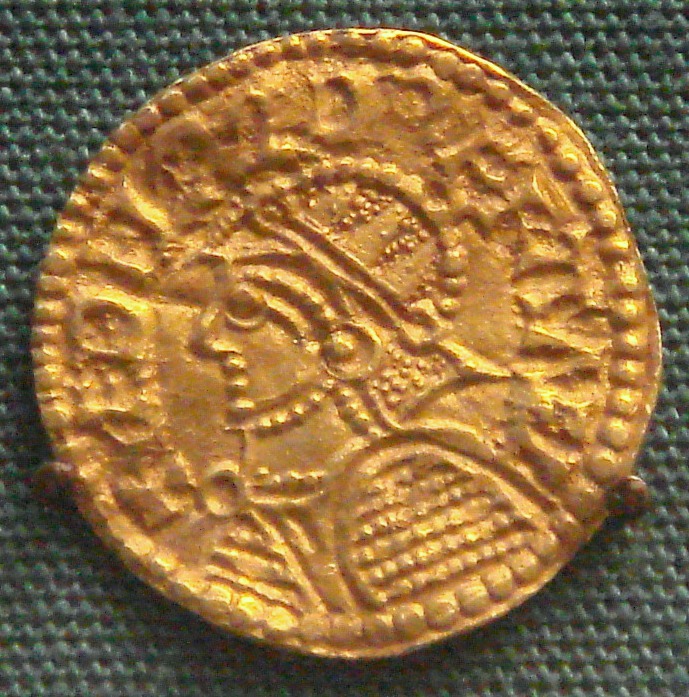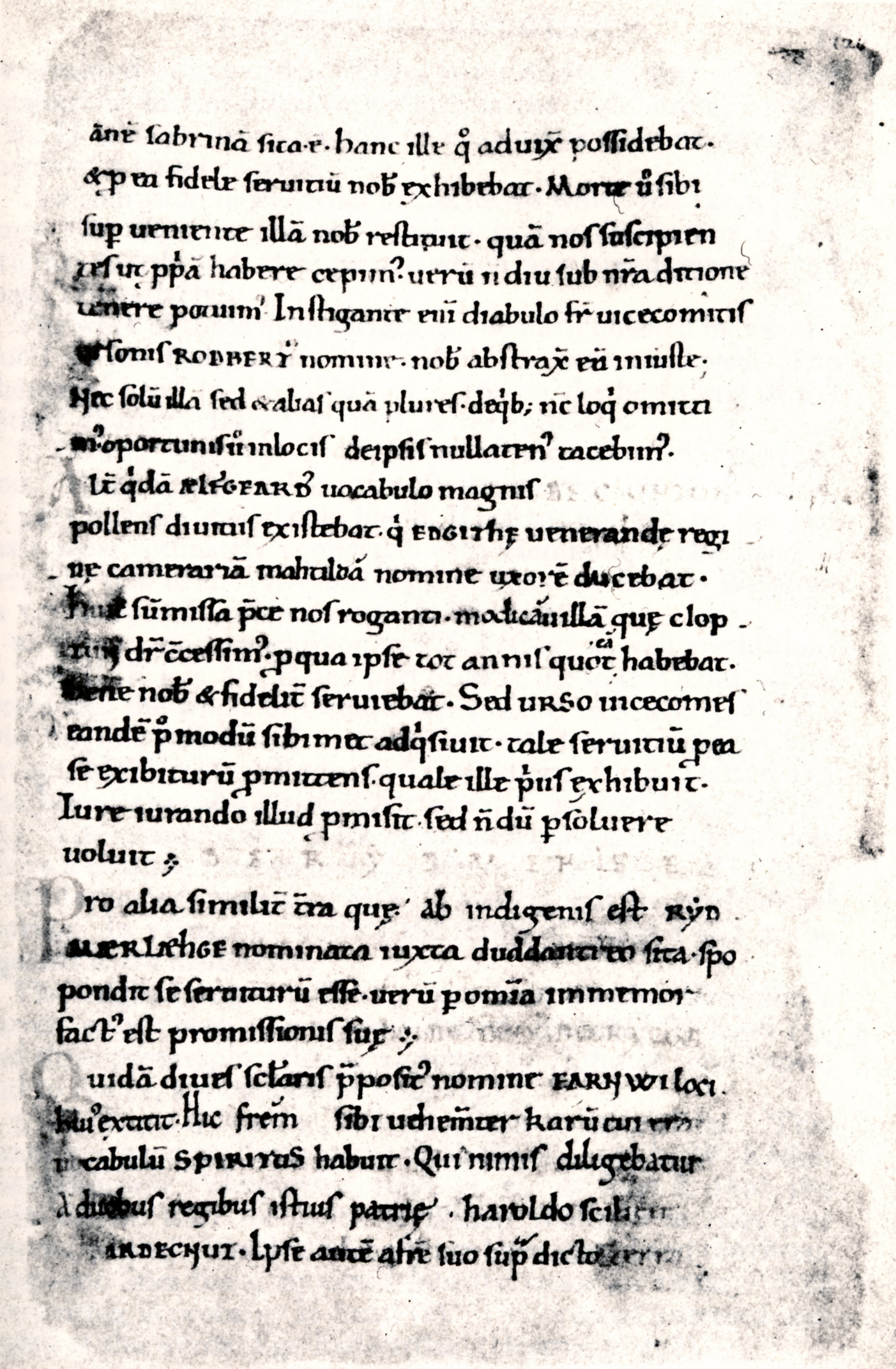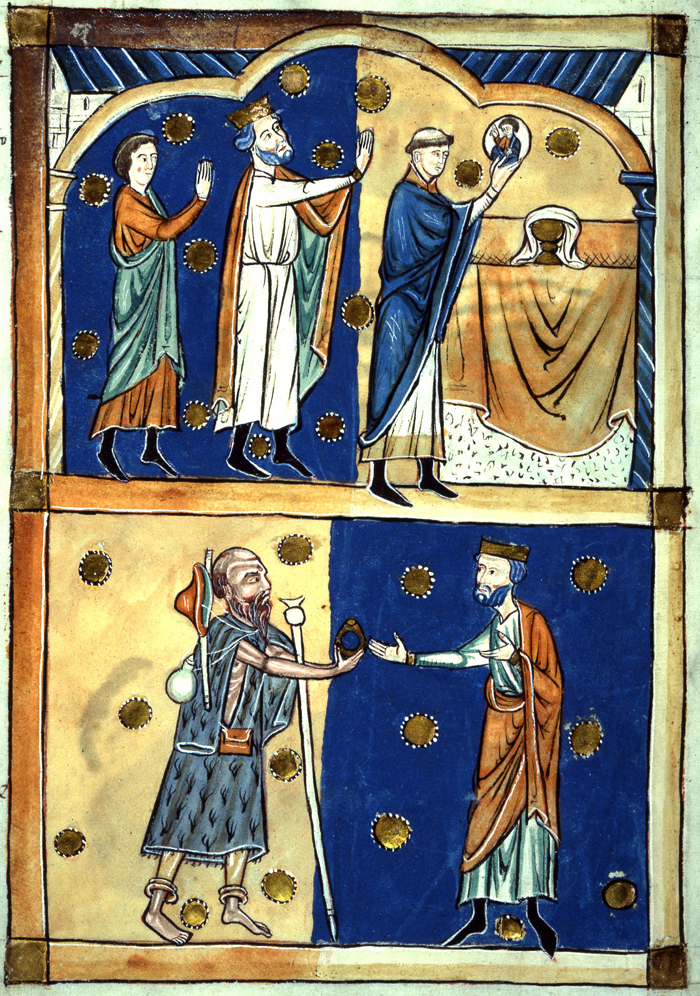|
Leofwine, Ealdorman Of The Hwicce
Leofwine (died in or after 1023) was appointed Ealdorman of the Hwicce by King Æthelred the Unready of England in 994. The territory of the Hwicce was a kingdom in the Western Midlands in the early Anglo-Saxon period, which soon became a subdivision of Mercia. Leofwine was the son of Ælfwine, who is otherwise unknown, but the family appears to have originated in the East Midlands. Leofwine and his sons were considered by the See of Worcester as spoliators who seized church land, but East Midlands religious establishments regarded them as benefactors. Under Æthelred, Leofwine's sphere of office was in the Hwicce areas of Worcestershire and Gloucestershire, but these counties were given to Danes by King Cnut soon after he gained the throne in 1016. However, Leofwine kept his rank and may have been appointed Ealdorman of Mercia in 1017 in succession to Eadric Streona, but Leofwine's eldest son Northman was murdered on Cnut's orders in the same year. Leofwine is last recorded in su ... [...More Info...] [...Related Items...] OR: [Wikipedia] [Google] [Baidu] |
Ealdorman
Ealdorman (, ) was a term in Anglo-Saxon England which originally applied to a man of high status, including some of royal birth, whose authority was independent of the king. It evolved in meaning and in the eighth century was sometimes applied to the former kings of territories which had submitted to great powers such as Mercia. In Wessex in the second half of the ninth century it meant the leaders of individual shires appointed by the king. By the tenth century ealdormen had become the local representatives of the West Saxon king of England. Ealdormen would lead in battle, preside over courts and levy taxation. Ealdormanries were the most prestigious royal appointments, the possession of noble families and semi-independent rulers. Their territories became large, often covering former kingdoms such as Mercia or East Anglia. Southern ealdormen often attended court, reflecting increasing centralisation of the kingdom, but the loyalty of northern ealdormen was more uncertain. In ... [...More Info...] [...Related Items...] OR: [Wikipedia] [Google] [Baidu] |
Hwicce
Hwicce () was a tribal kingdom in Anglo-Saxon England. According to the ''Anglo-Saxon Chronicle'', the kingdom was established in 577, after the Battle of Deorham. After 628, the kingdom became a client or sub-kingdom of Mercia as a result of the Battle of Cirencester. The ''Tribal Hidage'' assessed Hwicce at 7,000 hides, an agricultural economy akin to either the kingdom of Essex or Sussex. The exact boundaries of the kingdom remain uncertain, though it is likely that they coincided with those of the old Diocese of Worcester, founded in 679–680, the early bishops of which bore the title ''Episcopus Hwicciorum''. The kingdom would therefore have included Worcestershire except the northwestern tip, Gloucestershire except the Forest of Dean, the southwestern half of Warwickshire, the neighbourhood of Bath north of the Avon, part of west Oxfordshire and small parts of Herefordshire, Shropshire, Staffordshire and north-west Wiltshire. Name The etymology of the name "the Hw ... [...More Info...] [...Related Items...] OR: [Wikipedia] [Google] [Baidu] |
Æthelred The Unready
Æthelred II ( ang, Æþelræd, ;Different spellings of this king’s name most commonly found in modern texts are "Ethelred" and "Æthelred" (or "Aethelred"), the latter being closer to the original Old English form . Compare the modern dialect word ., non, Aðalráðr 966 – 23 April 1016), known as Æthelred the Unready, was King of the English from 978 to 1013 and again from 1014 until his death in 1016. His epithet does not derive from the modern word " unready", but rather from the Old English meaning "poorly advised"; it is a pun on his name, which means "well advised". Æthelred was the son of King Edgar the Peaceful and Queen Ælfthryth. He came to the throne at about the age of 12, following the assassination of his older half-brother, King Edward the Martyr. The chief problem of Æthelred's reign was conflict with the Danes. After several decades of relative peace, Danish raids on English territory began again in earnest in the 980s, becoming mark ... [...More Info...] [...Related Items...] OR: [Wikipedia] [Google] [Baidu] |
Mercia
la, Merciorum regnum , conventional_long_name=Kingdom of Mercia , common_name=Mercia , status=Kingdom , status_text=Independent kingdom (527–879)Client state of Wessex () , life_span=527–918 , era= Heptarchy , event_start= , date_start= , year_start=527 , event_end= , date_end= , year_end=918 , event1= , date_event1= , event2= , date_event2= , event3= , date_event3= , event4= , date_event4= , p1=Sub-Roman Britain , flag_p1=Vexilloid of the Roman Empire.svg , border_p1=no , p2=Hwicce , flag_p2= , p3=Kingdom of Lindsey , flag_p3= , p4=Kingdom of Northumbria , flag_p4= , s1=Kingdom of England , flag_s1=Flag of Wessex.svg , border_s1=no , s2= , flag_s2= , image_flag= , image_map=Mercian Supremacy x 4 alt.png , image_map_caption=The Kingdom of Mercia (thick line) and the kingdom's extent during the Mercian Supremacy (green shading) , national_motto= , national_anthem= , common_languages=Old English * Mercian dialect British Latin , currency=Sceat History of the English penny (c. ... [...More Info...] [...Related Items...] OR: [Wikipedia] [Google] [Baidu] |
East Midlands
The East Midlands is one of nine official regions of England at the ITL 1 statistical regions of England, first level of International Territorial Level, ITL for Statistics, statistical purposes. It comprises the eastern half of the area traditionally known as the Midlands. It consists of Leicestershire, Derbyshire, Lincolnshire (except North Lincolnshire, North and North East Lincolnshire), Northamptonshire, Nottinghamshire and Rutland. The region has an area of , with a population over 4.5 million in 2011. The most populous settlements in the region are Derby, England, Derby, Leicester, Lincoln, England, Lincoln, Mansfield, Nottinghamshire, Mansfield, Northampton and Nottingham, England, Nottingham. Other notable settlements include Boston, Lincolnshire, Boston, Buxton, Chesterfield, Derbyshire, Chesterfield, Corby, Northamptonshire, Corby, Coalville, Gainsborough, Lincolnshire, Gainsborough, Glossop, Grantham, Lincolnshire, Grantham, Hinckley, Leicestershire, Hinckley, K ... [...More Info...] [...Related Items...] OR: [Wikipedia] [Google] [Baidu] |
See Of Worcester
The Diocese of Worcester forms part of the Church of England ( Anglican) Province of Canterbury in England. The diocese was founded around 679 by St Theodore of Canterbury at Worcester to minister to the kingdom of the Hwicce, one of the many Anglo Saxon petty-kingdoms of that time. The original borders of the diocese are believed to be based on those of that ancient kingdom. Covering an area of it currently has parishes in: *the County of Worcestershire *the Metropolitan Borough of Dudley *northern Gloucestershire *urban villages along the edge of the south-east of the Metropolitan Borough of Wolverhampton *the Metropolitan Borough of Sandwell Currently the diocese has 190 parishes with 281 churches and 163 stipendiary clergy. The diocese is divided into two archdeaconries: *the Archdeaconry of Worcester *the Archdeaconry of Dudley On its creation the diocese included what is now southern and western Warwickshire (an area known as Felden). On 24 January 1837 the north ... [...More Info...] [...Related Items...] OR: [Wikipedia] [Google] [Baidu] |
Cnut
Cnut (; ang, Cnut cyning; non, Knútr inn ríki ; or , no, Knut den mektige, sv, Knut den Store. died 12 November 1035), also known as Cnut the Great and Canute, was King of England from 1016, King of Denmark from 1018, and King of Norway from 1028 until his death in 1035. The three kingdoms united under Cnut's rule are referred to together as the North Sea Empire. As a Danish prince, Cnut won the throne of England in 1016 in the wake of centuries of Viking activity in northwestern Europe. His later accession to the Danish throne in 1018 brought the crowns of England and Denmark together. Cnut sought to keep this power-base by uniting Danes and English under cultural bonds of wealth and custom. After a decade of conflict with opponents in Scandinavia, Cnut claimed the crown of Norway in Trondheim in 1028. The Swedish city Sigtuna was held by Cnut (he had coins struck there that called him king, but there is no narrative record of his occupation). In 1031, Malcolm II ... [...More Info...] [...Related Items...] OR: [Wikipedia] [Google] [Baidu] |
Eadric Streona
Eadric Streona (died 1017) was Ealdorman of Mercia from 1007 until he was killed by King Cnut. Eadric was given the epithet "Streona" (translated as "The Acquisitive”) in Hemming's Cartulary because he appropriated church land and funds for himself. Eadric became infamous in the Middle Ages because of his traitorous actions during the Danish re-conquest of England. Eadric was one of at least eight children and had relatively humble beginnings: his father Ethelric attended the court of King Æthelred the Unready, but was of no great significance and is not known to have had any titles. Even before becoming an ealdorman, Eadric seems to have acted as Æthelred's enforcer; in 1006 he instigated the killing of the Ealdorman of York, Elfhelm. Eadric was married to Æthelred's daughter Eadgyth by 1009, thus becoming his son-in-law. Eadric was appointed Ealdorman of Mercia in 1007. As an ealdorman, Eadric played an important role in the affairs of the kingdom. In 1009 he negotiate ... [...More Info...] [...Related Items...] OR: [Wikipedia] [Google] [Baidu] |
Northman, Son Of Leofwine
Northman (died 1017) was a Mercian chieftain of the early 11th century. A member of a powerful Mercian kinship (clan), he is known primarily for receiving the village of Twywell in Northamptonshire from King Æthelred II in 1013, and for his death by order of King Cnut the Great (Canute) in 1017. His violent end by Cnut contrasts with the successful career enjoyed by his brother Leofric, Earl of Mercia, Leofric, as Earl of Mercia during Cnut's reign. Northman is believed to have been an associate of the troublesome ealdorman Eadric Streona, who was killed with him. Family and status In the account of Northman's death by order of Cnut the Great, the chronicler John of Worcester styled Northman "...son of Leofwine, Ealdorman of the Hwicce", ''Dux'' ("duke", "ealdorman" or "warlord"). He is described as a brother of Leofric, Earl of Mercia, Leofric ''comes'' ("count" or "ealdorman"). No other source claims that Northman was an ealdorman, and so the authenticity of this account is in d ... [...More Info...] [...Related Items...] OR: [Wikipedia] [Google] [Baidu] |
Leofric, Earl Of Mercia
Leofric (died 31 August or 30 September 1057) was an Earl of Mercia. He founded monasteries at Coventry and Much Wenlock. Leofric is most remembered as the husband of Lady Godiva. Life Leofric was the son of Leofwine, Ealdorman of the Hwicce, who witnessed a charter in 997 for King Æthelred II. Leofric had three brothers: Northman, Edwin and Godwine. It is likely that Northman is the same as ''Northman Miles'' ("Northman the knight") to whom King Æthelred II granted the village of Twywell in Northamptonshire in 1013. Northman, according to the Chronicle of Crowland Abbey, the reliability of which is often doubted by historians, says he was a retainer (knight) of Eadric Streona, the Earl of Mercia.Baxter, ''Earls of Mercia'', pp. 29–30, and n. 45 for reference It adds that Northman had been killed upon Cnut's orders along with Eadric and others for this reason. Cnut "made Leofric ealdorman in place of his brother Northman, and afterwards held him in great affection." B ... [...More Info...] [...Related Items...] OR: [Wikipedia] [Google] [Baidu] |
Battle Of Rhyd-y-groes
A battle is an occurrence of combat in warfare between opposing military units of any number or size. A war usually consists of multiple battles. In general, a battle is a military engagement that is well defined in duration, area, and force commitment. An engagement with only limited commitment between the forces and without decisive results is sometimes called a skirmish. The word "battle" can also be used infrequently to refer to an entire operational campaign, although this usage greatly diverges from its conventional or customary meaning. Generally, the word "battle" is used for such campaigns if referring to a protracted combat encounter in which either one or both of the combatants had the same methods, resources, and strategic objectives throughout the encounter. Some prominent examples of this would be the Battle of the Atlantic, Battle of Britain, and Battle of Stalingrad, all in World War II. Wars and military campaigns are guided by military strategy, whereas bat ... [...More Info...] [...Related Items...] OR: [Wikipedia] [Google] [Baidu] |
Anglo-Saxon Ealdormen
The Anglo-Saxons were a Cultural identity, cultural group who inhabited England in the Early Middle Ages. They traced their origins to settlers who came to Britain from mainland Europe in the 5th century. However, the ethnogenesis of the Anglo-Saxons happened within Britain, and the identity was not merely imported. Anglo-Saxon identity arose from interaction between incoming groups from several Germanic peoples, Germanic tribes, both amongst themselves, and with Celtic Britons, indigenous Britons. Many of the natives, over time, adopted Anglo-Saxon culture and language and were assimilated. The Anglo-Saxons established the concept, and the Kingdom of England, Kingdom, of England, and though the modern English language owes somewhat less than 26% of its words to their language, this includes the vast majority of words used in everyday speech. Historically, the Anglo-Saxon period denotes the period in Britain between about 450 and 1066, after Anglo-Saxon settlement of Britain, th ... [...More Info...] [...Related Items...] OR: [Wikipedia] [Google] [Baidu] |
.jpg)






